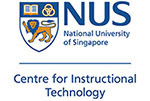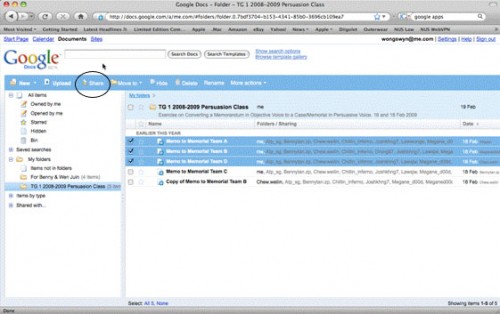
Assoc. Prof. Eleanor Wong, Director of the Legal Skills Programme at the NUS Law School shares how she used Google Docs to aid in improving her students' writing.
Introduction
Helping students to improve their written communication can be difficult.
Writing tends to be a solitary activity. It is hard to incorporate writing into an in-class activity and still keep the class active and engaging. If the teacher introduces some additional element in order to “spice things up”, it can distort the experience of writing and, perhaps, end up targeting unintended learning objectives. For example, if students are asked to write on the whiteboard in front of the whole class, this may introduce unintended stress into the process.
Thus, traditional methods for improving writing typically involve setting an assignment, letting the student write it at home and commenting on the work at some other time. Such methods permit the teacher to effectively comment on matters such as style and grammar. But a teacher is unable to investigate the student’s thinking process in real-time. This time lag makes it harder for the teacher to help the student improve his/her ability to match thought to expression (which is often a tougher challenge than issues of grammar/style).
In AY 2008-2009, teaching Legal Analysis Writing & Research to a Law 1 class, I discovered how Google Docs can help.
Google Docs
In a corner of the sprawling Google empire is a little gem of an application that permits real-time collaboration on documents, Google Docs at http://docs.google.com/.
You will have to set up an account, which is free. Once within the document collaboration programme (click screenshot below), you can invite others to collaborate on your documents by selecting "share".
Class Methodology
I used the Google Docs collaboration function to conduct a class on how to effectively craft and organize a written argument. I wanted students to think about 2 main things: (i) the order in which points should be presented to maximize persuasiveness, and (ii) how to use words carefully so as to make a strong impact without over-stating the position on behalf of the client.
Before the class began, I uploaded a “base document” which was couched in objective terms (i.e., it treated the subject matter neutrally without attempting to argue for one side or the other). Students were told to bring their laptops to class. At the start of the class, I divided the tutorial group into teams of 3 students each; I duplicated the “base document” for each team and named each copy according to the teams. Each team was then told to work on its “base document” and to edit it so that it would be a persuasive argument. Students were also told to supplement the “base document” with any additional points they wished.
Observations
Initially, the class seemed quiet compared to the usual (somewhat vocal) tutorial sessions. However, I observed that each team would discuss their thoughts a little and then individual members would attempt to rewrite the “base document” to reflect their discussion. More interestingly, I was able to monitor all the changes in real-time on my own computer (which was linked to a projector). Every few minutes, I would pick one team’s document, bring it up on the projector screen, use it to conduct a short discussion, and then leave the students to make further changes.
At the end of the session, all the teams had significantly changed their base documents to form the start of a persuasive argument.
I observed the following benefits of this method:
- Because I could see the drafting as it took place, I was able to stop the students at crucial decision points. We could discuss why they had taken those decisions and how to improve their writing to achieve their intentions.
- Students from all the teams would participate in these discussions and then I would observe them all attempting to incorporate the learning into the document. This allowed me to determine whether or not the students had understood the discussions and, if necessary, I could stop the writing again and have another discussion.
- Some students crafted multiple versions of the same paragraph (using Cut and Paste), keeping all versions in the document. This allowed us to discuss their relative strengths and weaknesses, something that is virtually impossible to simulate in an in-class white-board situation.
- Students in the same team would sometimes change each other sentences “on the fly”, thus simulating the writing equivalent of interjections and critique.
- Although the session was quiet in auditory terms, the students and I were able to observe energy, engagement and “movement” when we watched the changes occurring in documents (whether on their laptop screens or on the projector). Strangely, the class felt quite intense despite the predominant silence (except for the click-click of computer keys).
Conclusion
Most poor writing is due either to poor thinking or to poor transfer of thoughts to words. Google Docs helped shine some light into the solitary, occasionally murky, process of writing and can help teachers get closer to the heart of poor writing. Once there, the rest is up to the teacher.
Assoc. Prof. Eleanor Wong
Director, Legal Skills Programme
NUS Law School


